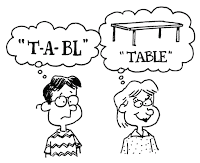Components of Reading
 Reading consists of five components:
Reading consists of five components:
- Phonemic Awareness
- Phonics
- Fluency & Prosody
- Comprehension
- Vocabulary
Difficulties Students with Disabilities have in Reading
Some common problems students with disabilities have in reading are:
- Decoding - Decoding is the ability to apply your knowledge of letter-sound relationships, including knowledge of letter patterns, to correctly pronounce written words.
- Reading Comprehension - the act of understanding what you read.
One Way to Make Reading Books Accessible
 Reading books can be made more accessible through the use of e-books. E-books can be an exciting development for all readers especially those who are print-disabled and blind readers because their properties make them ideal for finding alternative forms of access. When an e-book is presented in an accessible format on an accessible e-book reader, the user can choose to read the book using text-to-speech, Braille, or magnification. E-Books are readily available online through sites such as bookshare.org.
Reading books can be made more accessible through the use of e-books. E-books can be an exciting development for all readers especially those who are print-disabled and blind readers because their properties make them ideal for finding alternative forms of access. When an e-book is presented in an accessible format on an accessible e-book reader, the user can choose to read the book using text-to-speech, Braille, or magnification. E-Books are readily available online through sites such as bookshare.org.Reading AT Tool
The Intel Reader is is handheld mobile device that has a text-to-speech software; it uses technology to read text aloud. It is equipped with a high resolution camera that will capture texts and then convert the text into spoken words which it reads aloud to the user. The device highlights the words while they are being read, this feature assist students in identifying what is being read.Implementation
 The Intel Reader can be used for all age group. The reader can be implemented by scanning words from any age appropriate reading material in any classroom. It will then convert the words to speech and read aloud to students.
The Intel Reader can be used for all age group. The reader can be implemented by scanning words from any age appropriate reading material in any classroom. It will then convert the words to speech and read aloud to students.The Intel Reader can be accessed at:
https://www.gh-accessibility.com/products/intel/reader




No comments:
Post a Comment